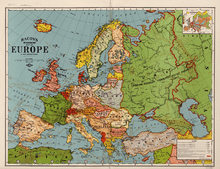Border states (Eastern Europe)

Border states or European buffer states was a political term used in the West before World War II, and referring to the European nations that won their independence from the Russian Empire after the Bolshevik Revolution of 1917, the treaty of Brest-Litovsk, and ultimately the defeat of the German Empire and Austria-Hungary in World War I. During the 20th century interwar period the nations of Western Europe implemented a border states policy[1] which aimed at uniting these nations in defense against the Soviet Union and communist expansionism. The border states were interchangeably Finland, Estonia, Latvia, Lithuania, Poland, Romania, and, until their annexation into the Soviet Union, short-lived Belarus and Ukraine.
The policy tended to see the border states as a cordon sanitaire, or buffer states, separating Western Europe from the newly formed Soviet Union.[2] It was never particularly successful, however; disputes and different allegiances between and within the group of states hindered unity. The matter was further complicated by the rise of the expansionist Nazi Germany. In 1939 Germany and the Soviet Union signed the Molotov–Ribbentrop Pact, which effectively divided the territory of the border states between those two countries. With the exception of Finland, all border states fell under Soviet occupation as a result of World War II.[2]
See also
References
- ↑ Kirby, D. G. (1980). Finland in the Twentieth Century: A History and an Interpretation. Minneapolis: University of Minnesota Press. p. 111. ISBN 0-8166-5802-1.
- 1 2 Stephanie C. Salzmann, Great Britain, Germany and the Soviet Union, Boydell Press 2013. Page 91. "Both countries regarded eastern Europe as a potential future troubleespot due to the numerous conflicting interests ... The border states were now regarded as a cordon sanitaire against the spread of communism beyond Soviet Russia, ..."